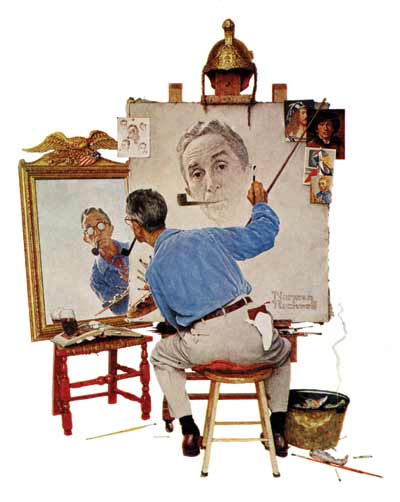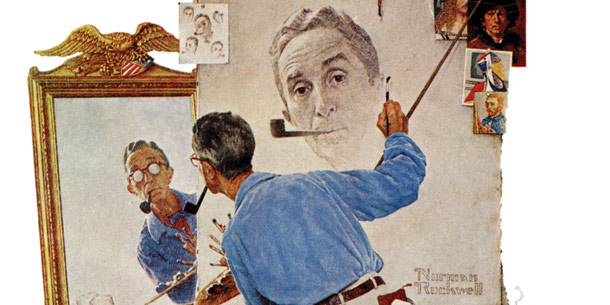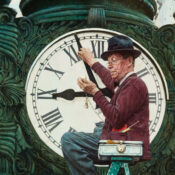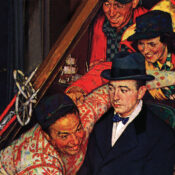
© SEPS
In 1960, Norman Rockwell produced one of the most famous self-portraits in American art. A naturally modest man, he clearly had some reservations about making himself the subject of a cover. He’d put himself on covers before, but usually only as a cameo, never the central figure.
In describing this work, Rockwell explained why his glasses look opaque. “I had to show that my glasses were fogged, and that I couldn’t actually see what I looked like — a homely, lanky fellow — and therefore, I could stretch the truth just a bit and paint myself looking more suave and debonair than I actually am.”
As visual reinforcement of his intentions, at the top of the easel, Rockwell has included a reminder to himself not to be taken in by appearances. He bought this helmet in a Paris antique shop, thinking it was the headdress of an ancient Greek or Roman soldier. Carrying it back to his hotel, he stopped to watch a firefighter working to save a burning building and realized that all French firemen wore helmets identical to the one he’d just purchased.
For all Rockwell’s self-deprecation, the painting is regarded by many as a thoughtful portrait of the artist’s three selves: the painter, the observer, and the public person.
This article is featured in the November/December 2017 issue of The Saturday Evening Post. Subscribe to the magazine for more art, inspiring stories, fiction, humor, and features from our archives.
Become a Saturday Evening Post member and enjoy unlimited access. Subscribe now




Comments
Looking again at this tricky “triple” self portrait, I notice the image in the mirror is not looking back at the seated artist; he is looking directly at you, the observer.
YOU are the second mirror required to produce the rectified image on the canvas because the image is how he would look to you (or how he wants you to remember him). Pure genius !
I have always been in awe (as an amateur portrait artist) of Mr. Rockwell’s amazing talent, not just with pencil & brush, but also sense of humor.
However, I’m surprized (as a physicist) that, reading through various analyses and collections of comments, I found no mention of the well-known fact that the image you see in a mirror is left/right reversed! You need two mirrors to double reverse your image to see what you look like to someone else.
So, to produce the fine image on (the painting of) the canvas, the (real) artist either used two mirrors or a camera.
I was given the ornament in the early 70s and told it was very collectible in America
I am now nearly eight so I thought it was time to pass on for someone else to enjoy.
Does it have any monetary value.
Thank you
Jena Castleton
I really liked the story decause it told how it was the self story
To Whom It May Concern:
My name is Hong-Nguyen (Gwen) Nguyen, a doctoral researcher at the University of Victoria, BC, Canada. I’m wondering if I can obtain permission to use and cite the painting in this article in my research dissertation.
Thank you very much.
Regards,
Gwen Nguyen
When you remember seeing them as a kid and its now 7 decades later you know the image was impactful